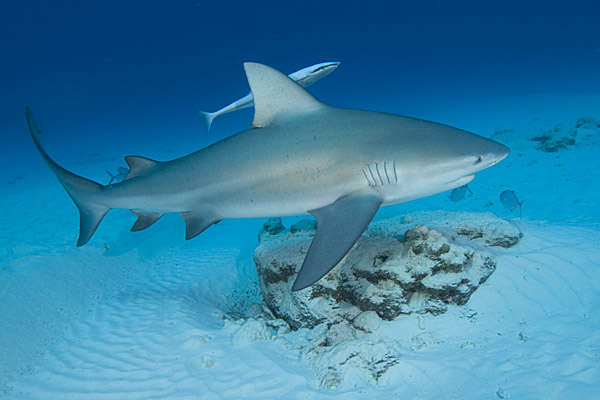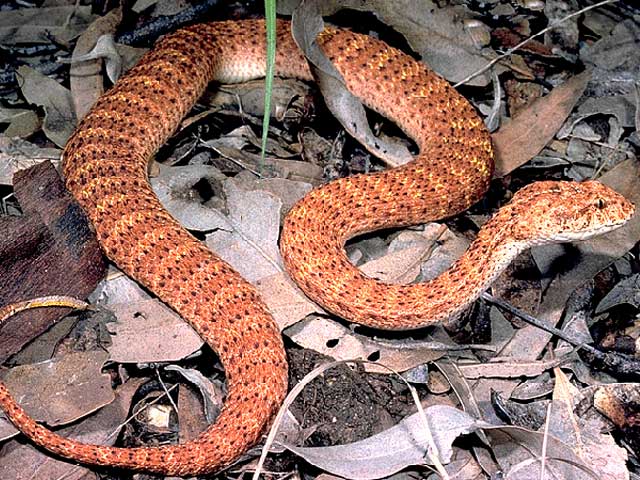Dangerous Australian Animals

Animal: Salt Water Crocodile
Location: Northern Australia & pars of Southeast Asia
Size: 10-20 feet long, 1,000-3,000 lbs (the biggest of crocodiles)
Speed: 15-18 mph
Food Source: Monkeys, kangaroos, dingos, wild boar, birds, buffalo, sharks, humans, & other critters
Defense Tactics: The best defense against these creatures is to keep a good distance. If a crocodile latches on to you
and begins the 'death roll', you are done for. You can try to jab it's eyes as hard as you can,
since that is its most sensitive spot, but the size and strength of these crocs is lethal.
Fatalities: 500+ per year

Animal: Brown Snake
Location: Australia
Size: 5-9 feet long
Speed: 7 mph
Food Source: Mice, rats, birds, lizards, and sometimes other snakes.
Defense Tactics: As with all snakes, keep out of striking distance and never try to handle them. The brown snake possesses
the 2nd most toxic poison of all land snakes, so you don't want to get bitten. If bitten, you have less than an hour to receive the
antivenom.
Fatalities: 10-20 per year

Animal: Bull Shark
Location: Indian & Pacific Oceans
Size: 7-12 feet long, 200-500 lbs
Speed: 15 mph
Food Source: Fish, dolphins, turtles, birds, smaller sharks, & other marine mammals.
Defense Tactics: Stay alert, even if you are in fresh water! Don't let this aggressive beast sneak up on you, and if you do see one, be sure to keep it in front of you. If it gets too close, attack its nose,
gills, or eyes (sensitive areas), and either get out of the water or try to find something you can lean against so the shark can't
circle around you.
Fatalities: 1-10 deaths per year

Animal: Tiger Shark
Location: Pacific, Indian, & Atlantic Oceans
Size: 10-14 feet long, 800-1,400 lbs
Speed: 20 mph
Food Source: Sea turtles, clams, stingrays, seals, birds, squid, fish, & dolphins.
Defense Tactics: Stay alert, even if you are in fresh water! Don't let this aggressive beast sneak up on you, and if you do see one, be sure to keep it in front of you. If it gets too close, attack its nose,
gills, or eyes (sensitive areas), and either get out of the water or try to find something you can lean against so the shark can't
circle around you. Avoid wearing bright colors because it can attracts sharks, and if you are bleeding, exit the water immediately because they can smell blood from miles away.
Fatalities: 1-5 deaths per year

Animal: Sea Snake
Location: Indian & Pacific Oceans
Size: 2-4 feet long
Speed: 5 mph
Food Source: Small fish, squid, & octopi
Defense Tactics: Almost all sea snakes pack a lethal venom, so don't try to catch one with your bare hands. Luckily, they are pretty mild mannered and will almost always try to flee before attempting to strike back.
Watch where you are walking & swimming and you shouldn't have any trouble with this delicate sea creature.
Fatalities: 0-1 deaths per year

Animal: Man O' War
Location: Tropical regions of the Indian and Pacific Oceans
Size: 30-150 feet long (includes the tentacles)
Speed: 5-7 mph
Food Source: Fish, plankton, and smaller organisms.
Defense Tactics: Similar to the treatment of a jellyfish, try to remove the stingers without touching them to avoid
further harm. Use sea water instead of fresh water to rinse it out. Seek immediate attention and take Benadryl if the person stung
experiences an allergic reaction.
Fatalities: Unknown

Animal: Emu
Location: Australia
Size: 3-6 feet tall, 50-130 lbs
Speed: 30 mph
Food Source: Plants, crickets, birds, catepillars, ants, fruits, & seeds
Defense Tactics: They make look furry and friendly, but don't be fooled by this dangerous bird. Equipped with a powerful beak and
razor-sharp claws, can Emu can easily tear through human flesh with just a single kick from its powerful legs. Give them space and don't try to
pet one of these wild animal should you come across one.
Fatalities: 0-2 deaths per year

Animal: Inland Taipan (aka Fierce Snake)
Location: Central Australia
Size: 4-7 feet long
Speed: 7 mph
Food Source: Rodents, birds, and small critters
Defense Tactics: Stay away from this snake - it's your only hope of survival, as it holds the crown for the world's most toxic
land snake. While this snake is generally not aggressive by nature, if bitten by it, enjoy your last 30 mintues of life.
Fatalities: Few

Animal: Tiger Snake
Location: Southern Australia
Size: 5-7 feet long
Speed: 7 mph
Food Source: Frogs, rodents, and small animals
Defense Tactics: This snake ranks as one of the most toxic snakes in the world so leave them be. They are usually found near
coastlines feeding off of frogs. If bitten by a tiger snake, the mortality rate is over 50% with no antivenom.
Fatalities: Few

Animal: Death Adder
Location: Australia & New Guinea
Size: 5-7 feet long
Speed: 7 mph
Food Source: Rodents, frogs, birds, and rabbits
Defense Tactics: The death adder has the fastest strike of all the snakes in the world, able to attack, inject venom, and go back to
striking position in under 0.15 of a second. Don't mistake it's tail for a worm and watch your step; this snake enjoys waiting for it's prey
to come to them.
Fatalities: 0-20 per year

Animal: Blue-Ringed Octopus
Location: Australian & Japan coasts
Size: < 16 oz.
Speed: 5-10 mph
Food Source: Crabs, shrimp, and small fish
Defense Tactics: While this sea creature is generally not very aggressive, it's best not to go near it in case it mistakes you as an
enemy. You don't want to get bitten by one of the most toxic creatures in the world, while you're in the middle of the ocean, far away from any medical
help.
Fatalities: Unknown

Animal: Scorpion Fish
Location: Indo-Pacific Ocean
Size: < 1 foot long
Speed: 5-10 mph
Food Source: Crustaceans and smaller fish
Defense Tactics: Stay away from the ocean floor, especially the darker, sandy colored crevices. Or if you go scuba diving, be sure to fully cover all
of your extremeties in case you run into a scorpion fish.
Fatalities: Unknown

Animal: Stonefish
Location: Indo-Pacific Ocean
Size: 1 foot long
Speed: 5-10 mph
Food Source: Jellyfish, sea-horses, and small fish
Defense Tactics: Stay away from this most toxic sea creature, as it ranks as one of the most toxic animals on the planet. Avoid any
stony/rocky areas in the Indo-Pacific Ocean, as this is where it tends to lie hidden under cover.
Fatalities: Unknown
comments powered by DisqusLearn about the dangerous european animals
